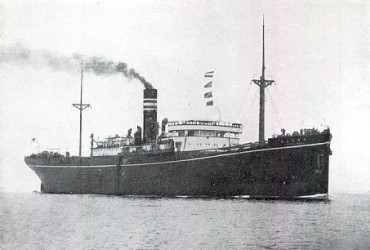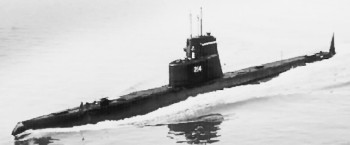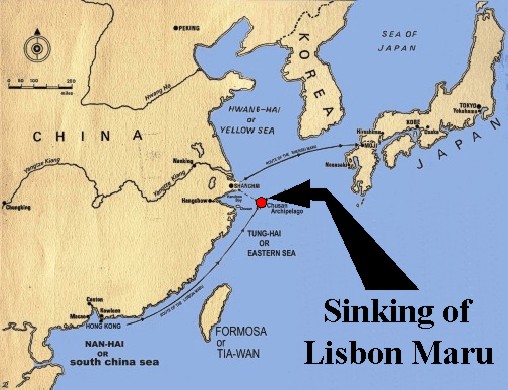|
Our first sight of the ship, which was named “Lisbon Maru”,
|

|
|
Lisbon Maru
|
|
Picture supplied by Geoff Coxon
|
|
was a large cargo ship, armed fore and aft, she was already getting up steam. On arrival at the ship’s side, we were rushed up the boarding steps on to the deck, there the draft was split up. The navalmen, and artillery men were pushed into a hold aft of the bridge, about 900 of them. Forward of the bridge was another large hold, this was to be our home for the voyage to Japan. Nine hundred of us were bundled into this hold, where conditions were such, that a pig would have objected. Our sleeping quarters was packed earth, no blankets and cramped space, and in the very bowels of the ship. Mostly everyone in the draft, was stricken with some disease and malnutrition. We looked on this as a bad omen and foreboding of a disaster which was about to eventuate. All next day large numbers of wounded Jap soldiers came aboard, filling all the available space above us. At the turn of the tide on the 27 September the “Lisbon Maru” got into motion and turned her nose towards the open sea and set out for the journey to Japan. After three days at sea, hugging the China coast, the ship became a hell in which survival was slowly but surely drifting from us. During the day, our food and water was lowered down to us in buckets. We were allowed on deck, in groups one time per day to go to the toilets which were wooden structures built out from the side of the upper deck. You can imagine what the sleeping accommodation was like, with men suffering from dysentery and diarrhoea, it was abominable. The ship’s journey had been uneventful so far, but there seemed to be uneasiness showing among the wounded Japanese as if there was a premonition of disaster. Seven o’clock next morning and disaster did strike in the shape of a torpedo which struck in the engine-room.
|

|
|
USS Grouper SS-214
|
|
Launched the Attack on the Lisbon Maru
|
|
`The "Lisbon Maru" was armed and carried Japanese troops as well as Prisoners of War. She bore no sign that she was a P.O.W. Ship. The American submarine was fully justified in sinking her, there has never been any criticism of the Americans for their action, only regret.´
|
|
Picture supplied by Geoff Coxon
|
|
There was an almighty thud and the ship seemed to shudder to a halt, then start to settle down in the water. Panic seemed to spread among the crew. There was the ringing of bells, whistles and shouting and the ship’s guns were blazing away. Aircraft were also flying overhead, seeking the submarine. After a while the panic died down, but now there was a different sound to be heard by us. It was the sound of rushing water. Somebody shouted out that the ship was sinking. This started an immediate panic for the ladder leading out of the hold. Before anybody could get to the top, the Japs had started putting the hatchboards over the hold and the canvas covers were being battened down. The intention was quite clear, nobody was to survive. We firmly believed the Japs would not let us drown. They could not be so heartless, that they would let 1800 helpless men die. The ship was sinking slowly by the stern and we waited and waited for the Japs to mount a rescue mission. No attempt was made to let light or fresh air into the hold which was stifling. Slowly the hours passed and we were wondering how our mates in the aft hold were getting on. We knew that they had been forced to man the pumps, but that their weakness and ill health would prevent them from manning the pumps much longer. Sheer exhaustion would creep in and that would be the end. Messages in morse code were being tapped out on the steel pipes running along the ship. We heard a ship coming alongside during the night, but only the wounded Jap soldiers and the crew were taken off. We were now in a desperate situation, the ship was a drifting derelict, carrying a cargo of human wrecks, who were getting near the end of their tether. It was now twenty four hours since the torpedo had struck and we sensed that the ship could go down anytime now. By now the rear end was under water and all the men in the aft hold had drowned. It became a matter of urgency that we had to find some way out of the position we were in, or go down with the ship. In the past hour, someone had got hold of something sharp and was working to wear away a slit in the canvas covers covering the hatchboards. After extreme hardship by the men concerned, he managed to get a slit in the canvas, which he widened enough to be able to push up a hatchboard. Several other hatchboards were pushed up and aside. There was a rush to get out, but unknown to these men, an armed section armed with a machine-gun had been left on board to deal with a breakout. The first few men out fell in a hail of bullets, but the machine gun crew were quickly and effectively despatched to a watery grave. The hold was quickly opened up and a rush started for the ladder leading out of the hold. In the mad rush to the side, the ship heeled over and water started pouring into the hold.
|

|
|
Sinking of the Lisbon Maru
|
|
Map supplied by Geoff Coxon
|
|
The end was nigh and a super human effort was made to get everyone out before the ship went down. When I got out of the hold, I could see bodies floating face down, all around. The hold was filling rapidly now and the ship was beginning to go down quicker. I was pushed overboard by the mad rush to get off as she sank lower and lower.
My first reaction as I hit the water, was self preservation. I saw a hatchboard floating near me and immediately struck out for it. I was a good swimmer, but I was in a very weak condition and this hatchboard was going to be my lifesaver. I had been about ten hours in the water, when I noticed several small ships approaching. I was horrified to see these ships, ploughing through groups of swimmers and then machine-gun fire could be heard. The survivors were being massacred and there was nothing could be done to stop it. How helpless can people feel, in the face of such adversity, it would take a miracle to save us now. This miracle duly took place in the shape of a large Chinese fishing fleet coming into view. The Jap ships started to pick up survivors. I was one of the lucky ones who was picked up. The survivors who were picked up were landed at a place called Woosung not far from Shanghai. Most of the survivors were completely naked and were suffering from exposure and all were completely exhausted and ravenously hungry. To make matters worse, we were sitting on the cold stone of the quay. No attempt was made to supply us with warm clothing or a blanket to wrap ourselves in, there must have been about 800 survivors out of the 1800 who boarded the ship. We were encircled by machine-gun crews and we dared not talk to one another at the risk of getting a beating. Later that day, we were all packed into the hold of a Chinese Junk, under armed guard to await further orders. The armed guard could not have been more brutal, they took this opportunity to rob anybody who had a watch on their wrist or rings on their fingers. You had to give or suffer a beating or a blow from a rifle butt. In the condition that we were in, we did not argue. There was no sleep and no food that night. By next morning, a few of the prisoners had perished from exposure, or had simply given up and let their life slip away. Words cannot describe the horrendous tragedy, that had befallen the prisoners since they left Hong Kong on the hell ship “Lisbon Maru”.
|
|
|
|
|
|
![wh_l_arr[1] wh_l_arr[1]](../assets/images/wh_l_arr_1_.gif)
|
Previous Page
|
Next Page
|

|
|
|
|
|
|
|
|
